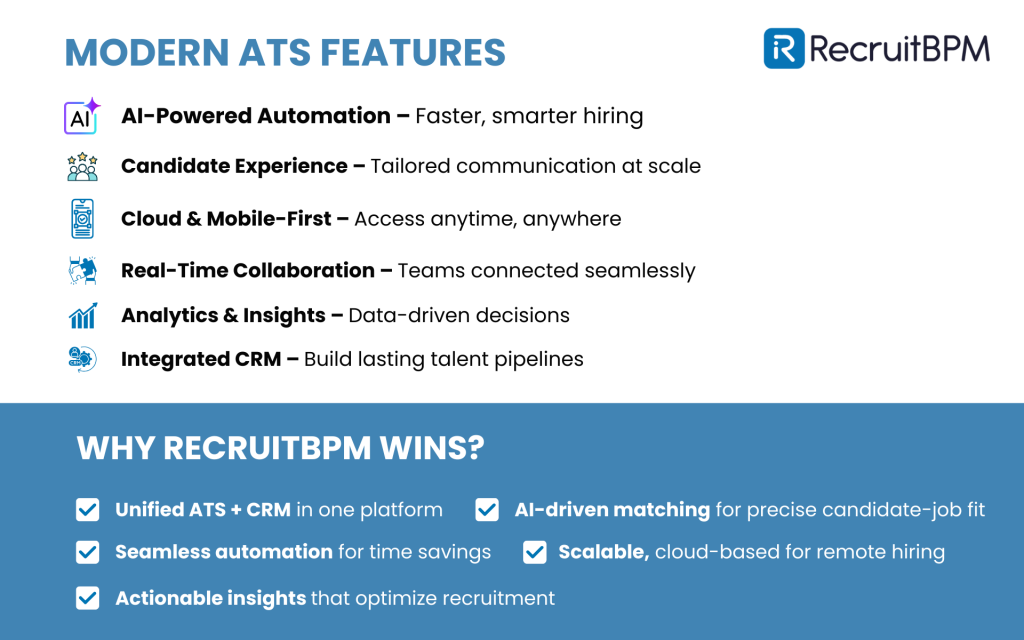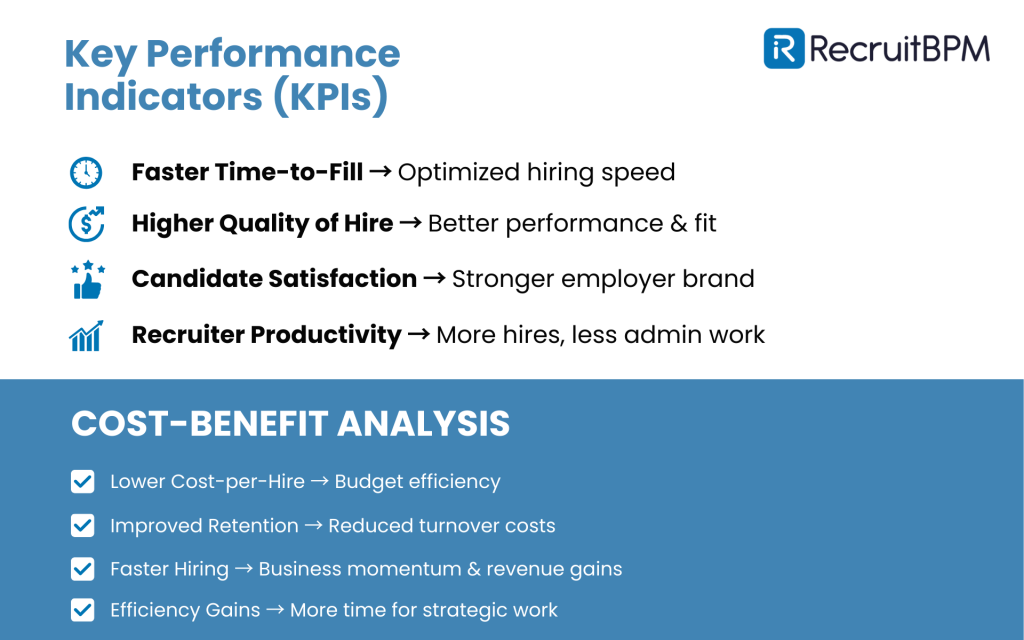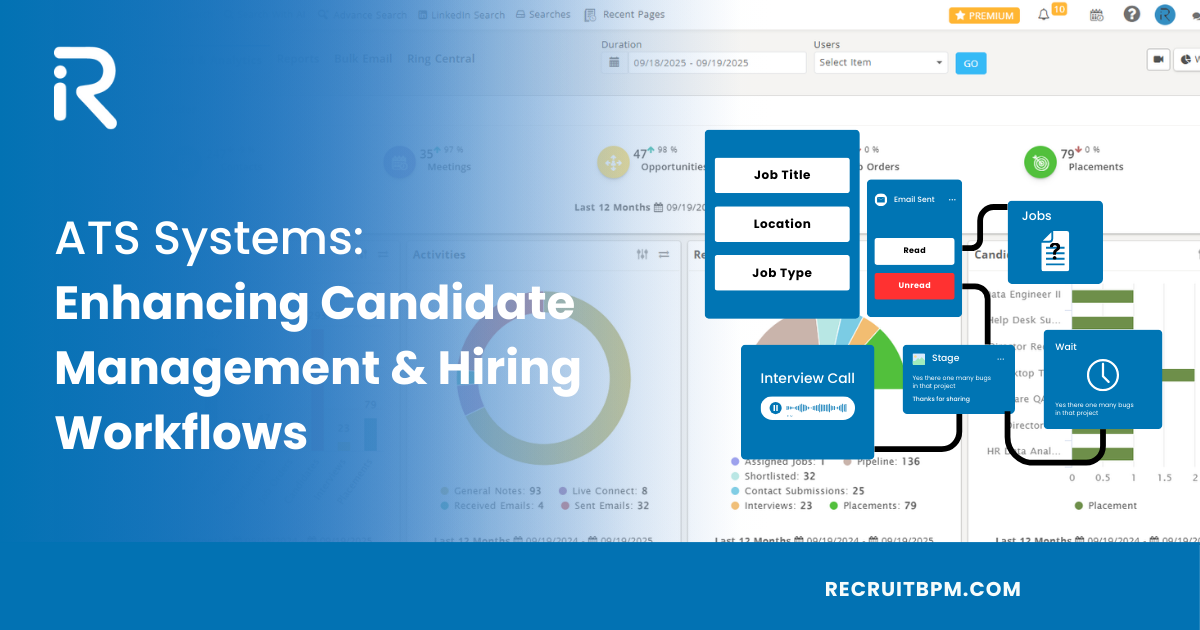Modern recruitment faces unprecedented challenges. Top talent disappears within days, hiring managers demand faster results, and candidates expect seamless experiences. Without the right technology, your team drowns in manual processes while competitors secure the best hires.
This reality drives 78% of companies to embrace AI-powered hiring solutions by 2025. Applicant Tracking Systems have evolved far beyond simple resume storage. Today’s ATS platforms integrate talent acquisition, workflow automation, and relationship management into unified solutions.
RecruitBPM transforms this complex landscape into streamlined success. Our AI-driven platform combines deep functionality with an intuitive design. You get comprehensive candidate management and intelligent hiring workflows in one powerful system.
What Are ATS Systems in 2025?

Today’s ATS represents a fundamental shift in talent acquisition technology. These systems function as comprehensive talent management platforms. They automate repetitive tasks, enhance decision-making, and create exceptional candidate experiences.
Modern ATS solutions integrate artificial intelligence, machine learning, and predictive analytics. They process thousands of applications simultaneously while maintaining personalized candidate interactions. This evolution enables recruiters to focus on relationship building rather than administrative tasks.
The transformation continues accelerating. Cloud-based deployment eliminates infrastructure concerns. Mobile-first design supports remote hiring. Real-time collaboration tools connect distributed teams seamlessly.
Core Components of Modern ATS
Advanced ATS platforms combine four essential elements. Candidate database management centralizes all applicant information and interaction history. Workflow automation handles repetitive processes like interview scheduling and status updates.
CRM integration maintains long-term candidate relationships beyond immediate hiring needs. Analytics and reporting provide data-driven insights into recruitment performance and bottlenecks.
These components work together seamlessly. When a candidate applies, the system automatically parses their resume. It matches their profile against open positions. Relevant stakeholders receive notifications while the candidate gets confirmation.
RecruitBPM excels in this integration approach. Our platform unifies ATS and CRM functionality without compromise. You manage both active applications and future talent prospects within one system.
The Critical Role of Candidate Management
Building Sustainable Talent Pipelines
Proactive candidate relationship building separates top-performing recruitment teams from average ones. Smart organizations invest in talent pipeline development before urgent hiring needs arise. This approach reduces time-to-hire by 50% on average.
Effective talent pipelines require consistent nurturing strategies. Regular touchpoints keep qualified candidates engaged over extended periods. Personalized content sharing demonstrates ongoing value and maintains interest levels.
Successful pipeline management involves segmentation based on skills, experience, and interests. Different candidate groups receive tailored communications. Technical professionals might appreciate industry trend updates. Senior executives prefer strategic insights and market analysis.
Enhancing Candidate Experience Through ATS
Candidate experience directly impacts your ability to attract top talent. 82% of candidates expect clear timelines and proper support throughout the application process. Poor experiences damage an employer’s brand reputation and reduce offer acceptance rates.
Modern ATS platforms create seamless application journeys. Mobile-optimized career pages load quickly on any device. Application forms capture necessary information without overwhelming candidates. Automated acknowledgments confirm successful submissions immediately.
Transparent communication workflows keep candidates informed at every stage. Status updates arrive promptly when decisions occur. Interview scheduling happens through self-service portals. Feedback collection helps continuous process improvement.
RecruitBPM prioritizes candidate experience in every feature design. Our intuitive interface guides applicants through streamlined processes. Automated communications maintain engagement while reducing recruiter workload.
RecruitBPM’s Candidate Relationship Management Features
Our unified platform manages comprehensive candidate relationships throughout their entire journey. The centralized database stores detailed profiles including skills, preferences, and interaction history. Advanced search capabilities help you find relevant candidates quickly.
Personalized communication templates maintain consistent brand messaging while allowing customization. Automated sequences nurture passive candidates over time. Integration with social media platforms enriches candidate profiles with current information.
Candidate journey tracking provides complete visibility into every interaction. You understand exactly where each person stands in your process. This transparency enables better decision-making and improved relationship management.
Optimizing Hiring Workflows with ATS Technology
Automated Workflow Design
Custom hiring pipeline creation adapts to your unique processes. Different roles require different evaluation stages. Executive positions might need multiple interview rounds. Entry-level roles could emphasize skills assessments.
Stage-based automation triggers eliminate manual process management. Moving candidates between stages automatically sends notifications. Interview scheduling invitations go out immediately when candidates advance. Rejection communications happen promptly when decisions are finalized.
Approval process management ensures compliance with organizational requirements. Budget approvals route to appropriate managers. Legal reviews happen automatically for sensitive positions. Documentation requirements are fulfilled systematically.
Task assignment and tracking keep everyone accountable. Interviewers receive preparation materials automatically. Hiring managers get reminded about pending decisions. Recruiting coordinators track overall pipeline health.
AI-Powered Workflow Enhancement
Resume parsing and ranking happen instantly when applications arrive. AI algorithms extract relevant information accurately. Skills, experience, and qualifications get identified automatically. Candidate profiles populate without manual data entry.
Candidate matching algorithms compare applications against position requirements. Scoring systems rank applicants by fit quality. Top candidates rise to the recruiter’s attention immediately. Less qualified applications get filtered appropriately.
Predictive analytics identify candidates likely to succeed in specific roles. Historical hiring data informs these predictions. Success patterns help refine future candidate evaluation. This intelligence improves overall hiring quality significantly.
Automated screening and pre-qualification reduce recruiter workload dramatically. Basic requirements get verified automatically. Skills assessments launch based on predefined criteria. Only qualified candidates consume valuable interview time.
RecruitBPM’s Workflow Automation Capabilities
Our no-code workflow builder empowers non-technical users to create sophisticated processes. Drag-and-drop interface makes complex automation accessible. Conditional logic handles various scenarios automatically. Custom triggers respond to specific events instantly.
Customizable hiring stages reflect your organization’s unique needs. Sales roles might emphasize presentation skills. Technical positions could require coding challenges. Management roles need leadership assessment components.
Automated interview scheduling eliminates coordination headaches. Candidates choose from available time slots. Calendar invitations generate automatically. Reminder notifications reduce no-show rates significantly.
Integrated video conferencing tools support remote hiring seamlessly. Interview links generate automatically. Recording capabilities enable review and collaboration. Technical quality ensures professional experiences.
Advanced ATS Features for 2025
Integration Capabilities
Job board syndication across 5,000+ platforms maximizes candidate reach. Single-click posting distributes openings widely. Automated job renewal maintains visibility levels. Performance tracking identifies the most effective sources.
HRIS and payroll system connections streamline new hire onboarding. Employee data transfers automatically upon hiring. Benefits enrollment begins immediately. Payroll setup happens without duplicate data entry.
CRM platform integrations maintain comprehensive relationship histories. Sales teams access hiring pipeline information. Client relationships connect to recruitment activities. Revenue opportunities are linked to talent acquisition efforts.
Social media recruiting tools expand sourcing capabilities. LinkedIn integration enables direct candidate outreach. Facebook and Twitter job sharing increases visibility. Social profile enrichment improves candidate understanding.
Analytics and Business Intelligence
Time-to-hire metrics identify process bottlenecks and improvement opportunities. Average cycle times reveal efficiency trends. Stage-specific delays highlight problem areas. Comparative analysis shows recruiter performance differences.
Cost-per-hire analysis demonstrates recruitment ROI clearly. Source costs compare across different channels. Quality metrics balance efficiency with effectiveness. Budget allocation insights optimize resource deployment.
Source effectiveness tracking identifies the best candidate origins. Job boards, referrals, and social media performance compare directly. Investment decisions become data-driven rather than intuitive. Marketing spend focuses on proven channels.
Diversity and inclusion reporting ensures equitable hiring practices. Demographic tracking identifies potential biases. Pipeline analysis reveals where diverse candidates exit. Corrective actions target specific improvement areas.
Mobile and Remote Hiring Support
Mobile-optimized candidate experiences accommodate modern job seeker preferences. Applications can be completed easily on smartphones. Document uploads happen seamlessly. Status checking requires no desktop access.
Remote interview capabilities support distributed hiring teams. Video quality remains professional across platforms. Screen sharing enables technical assessments. Recording functions facilitate collaborative evaluation.
Digital offer management accelerates the final hiring stages. Electronic signatures eliminate mailing delays. Terms negotiation happens through secure portals. Acceptance tracking provides real-time status updates.
Cloud-based accessibility ensures continuous operation from anywhere. Data synchronization happens automatically across devices. Team collaboration continues regardless of location. Security protocols protect sensitive information consistently.
Industry-Specific ATS Solutions
Staffing Agencies and Recruitment Firms
Client management integration connects recruitment activities to business development. Account histories include all placement activities. Revenue tracking ties directly to successful hires. Relationship management spans multiple contacts per organization.
Vendor management systems coordinate external recruiter networks. Performance tracking identifies top contributors. Payment processing handles complex commission structures. Collaboration tools facilitate information sharing.
Split placement tracking manages multi-party recruiting arrangements. Revenue sharing calculations happen automatically. Credit assignment follows predetermined agreements. Dispute resolution maintains detailed audit trails.
Commission management ensures accurate recruiter compensation. Complex structures accommodate various arrangement types. Automated calculations reduce administrative overhead. Transparent reporting builds trust and motivation.
Corporate and In-House Recruiting
Internal mobility tracking promotes employee development and retention. Current employee skills databases identify internal candidates. Career path planning tools support advancement discussions. Transfer processes follow consistent procedures.
Employee referral programs harness workforce networks effectively. Automated tracking credits referring employees appropriately. Reward processing happens seamlessly after successful hires. Program metrics demonstrate ROI clearly.
Compliance management ensures adherence to employment regulations. EEOC reporting happens automatically from hiring data. Documentation requirements are fulfilled systematically. Audit trails provide complete activity histories.
Onboarding integration creates seamless new hire experiences. Equipment ordering begins immediately after acceptance. Training schedules generate automatically. Buddy assignments facilitate cultural integration.
Executive Search and Specialized Recruiting
Confidential search capabilities protect sensitive hiring activities. Anonymous job postings maintain discretion. Secure communication channels prevent information leaks. Access controls limit visibility appropriately.
Advanced candidate sourcing tools reach passive talent effectively. Boolean search capabilities handle complex criteria. Social media integration expands reach significantly. Research tools provide comprehensive candidate intelligence.
Relationship management tools maintain long-term executive networks. Interaction histories span multiple years and opportunities. Market intelligence helps with positioning and negotiation. Trust building happens through consistent engagement.
Project-based hiring workflows accommodate unique executive search requirements. Milestone tracking ensures progress transparency. Client communication happens at predetermined intervals. Deliverable management maintains quality standards.
Measuring ATS Success and ROI

Key Performance Indicators
Hiring velocity improvements demonstrate operational efficiency gains. Reduced time-to-fill metrics show process optimization success. Pipeline conversion rates reveal qualification accuracy. Interviewer utilization indicates resource optimization.
Quality of hire metrics connect recruitment activities to business outcomes. New hire performance ratings validate selection processes. Retention rates demonstrate cultural fit accuracy. Promotion rates indicate growth potential identification.
Candidate satisfaction scores reflect experience quality. Survey responses provide improvement insights. Net Promoter Scores indicate brand strength. Completion rates show process accessibility.
Recruiter productivity gains justify technology investments. The number of applications processed per recruiter increases significantly. Interview-to-hire ratios improve through better screening. Administrative time reduces dramatically through automation.
Cost-Benefit Analysis
Reduced time-to-fill impact creates substantial cost savings. Every day positions remain open costs money. Faster hiring preserves business momentum. Revenue generation begins sooner with quicker placements.
Lower cost-per-hire achievement improves budget efficiency. Reduced agency fees save significant money. Internal efficiency gains compound over time. Technology investments pay for themselves quickly.
Improved retention rates reduce replacement costs. Better cultural fits stay longer. Reduced turnover saves training investments. Stable teams perform more effectively.
Operational efficiency gains free resources for strategic activities. Less administrative work enables relationship building. Higher-value activities get appropriate attention. Business growth accelerates through better talent acquisition.
Future-Proofing Your Hiring Process
Emerging ATS Trends for 2025-2026
AI agent integration will automate increasingly complex recruiting tasks. Conversational agents will handle candidate screening autonomously. Natural language processing will improve interaction quality. Machine learning will enhance decision accuracy continuously.
Conversational recruiting bots will manage initial candidate interactions. 24/7 availability will improve response times. Consistent messaging will strengthen brand communication. Qualification processes will happen automatically.
Predictive hiring analytics will forecast success probabilities accurately. Historical patterns will inform future decisions. Risk assessment will reduce poor hiring decisions. Success modeling will guide candidate evaluation.
Enhanced diversity tools will promote equitable hiring practices. Bias detection will identify problematic patterns. Inclusive language suggestions will improve job descriptions. Pipeline analysis will ensure representative candidate pools.
Preparing for Recruitment Evolution
Scalability considerations ensure technology grows with your organization. Cloud-based platforms handle volume increases automatically. User licensing adapts to team size changes. Feature availability expands with business needs.
Technology adaptation strategies maintain competitive advantages. Regular platform updates provide new capabilities. Training programs keep teams current with features. Change management processes smooth transitions.
Continuous improvement approaches optimize performance over time. Regular metric reviews identify optimization opportunities. User feedback drives feature prioritization. Best practice sharing accelerates learning.
Market trend responsiveness maintains relevance in changing environments. Industry developments influence platform evolution. Competitive analysis informs strategic decisions. Innovation adoption keeps organizations ahead.
How RecruitBPM Transforms Your Hiring Process?
Comprehensive ATS + CRM Solution
All-in-one platform benefits eliminate integration complexity and reduce vendor management overhead. Single sign-on access streamlines the user experience. Unified data model prevents information silos. A consistent interface reduces training requirements.
Seamless data integration ensures information accuracy across all functions. Candidate profiles update automatically in both systems. Client relationship data connects to recruitment activities. Reporting spans complete business operations.
Unified user experience reduces context switching and improves productivity. Navigation remains consistent across all features. Search functionality works universally. User preferences apply throughout the platform.
Scalable architecture accommodates growth without performance degradation. Cloud-based infrastructure handles volume increases automatically. Feature availability expands with subscription tiers. Geographic expansion happens without technical barriers.
AI-Driven Innovation
Smart candidate matching uses machine learning to improve accuracy over time. Algorithm training happens continuously from user feedback. Success patterns refine future recommendations. Accuracy improvements compound with usage.
Automated workflow optimization identifies and eliminates inefficiencies. Process analytics reveal bottleneck locations. Suggested improvements appear automatically. Implementation happens through guided configurations.
Predictive hiring insights forecast outcomes before decisions are finalized. Success probability calculations inform choice-making. Risk assessments highlight potential problems. Confidence intervals provide decision context.
Continuous learning capabilities ensure platform evolution with your needs. User behavior analysis drives feature development. Success metrics guide algorithm improvements. Feedback loops create self-improving systems.
Implementation and Support
Quick deployment process minimizes disruption to ongoing operations. Standard implementations are complete within weeks. Data migration happens securely and accurately. User access begins immediately after setup.
Training and onboarding support ensure successful adoption. Comprehensive documentation covers all features. Video tutorials provide step-by-step guidance. Live training sessions address specific needs.
Ongoing optimization services maximize platform value. Regular health checks identify improvement opportunities. Performance tuning maintains optimal speed. Feature utilization analysis guides training focus.
24/7 technical assistance ensures continuous operation. Multiple support channels accommodate preferences. Response time guarantees provide certainty. Issue escalation procedures handle complex problems.

Conclusion
ATS systems have become essential infrastructure for successful talent acquisition. Modern platforms integrate candidate management, workflow automation, and business intelligence into unified solutions. Organizations without sophisticated ATS technology fall behind in competitive hiring markets.
RecruitBPM delivers comprehensive advantages through our AI-driven, future-focused platform. You get unified ATS and CRM capabilities without compromise. Advanced automation eliminates manual processes while enhancing candidate experiences.
Our solution grows with your organization while maintaining simplicity. Whether you’re a staffing agency, corporate recruiter, or executive search firm, RecruitBPM adapts to your unique needs.
Ready to transform your hiring process? Schedule a personalized demonstration to see how RecruitBPM can revolutionize your talent acquisition. Discover the power of truly integrated recruitment technology designed for modern hiring challenges.
The future of recruitment is here. Your competitive advantage begins with the right technology foundation.

















